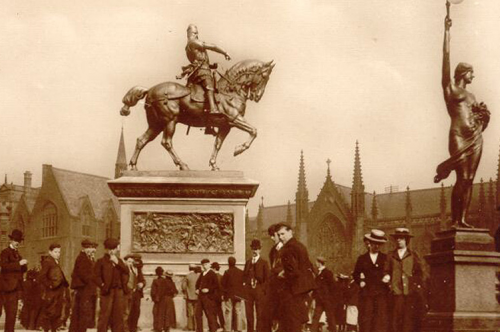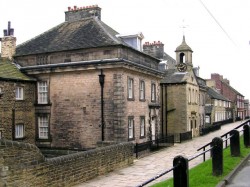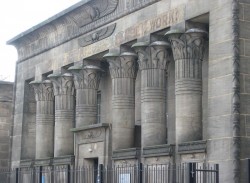
There is an old legend about Sir Walter Raleigh: whilst imprisoned in the Tower of London in the early years of the Stuart dynasty, he began work on his grand narrative Historie of the World. Whilst writing, however, he looked out the tiny shaft in the wall of his cold stone cell, provoked by the distant noise of two quarrelling guardsmen.
He struggled to hear what they were talking about, and could only make out their gestures. He turned back to his history, and suddenly – thinking of the sight of those two guards – tore it to pieces and never returned to it.
Watching those guardsmen, Raleigh saw the futility of his own endeavour, his own history: struggling to make a complete and comprehensive story out of only a series of dimly-heard words and half-comprehended sights.
The historian’s work is a doomed project from the off.
But if history is not a narrative already written, but an entire digest of vignettes, then not only does it become a more worthwhile endeavour; it also becomes more interesting and more rewarding.
This weekend, hundreds of sites across the country are being opened to the public for the Heritage Open Days programme. Here, I want to look at just three of the more well-known but perhaps little-understood spots in different quarters of Leeds: each one with a radically different take to offer on the “Leeds story”. The council and the newspapers have kept to their laughably bad form at selling them, offering the public a Spartan diet of “fine buildings of architectural interest” and “important historic” sites, without ever suggesting what may be remotely fine or historic about them. But here we may as well make a start, and look at the stories that live on inside each one…
Moravian Settlement, Fulneck
Over half a century before Martin Luther nailed his Ninety-Five Theses to the door of the All Saints’ in Wittenberg, a modest new Church was established further south in Bohemia, in protest at the rule of Rome and in pursuit of a return to their native traditions of Eastern Orthodox Christianity.
Arguing for liturgy in the language of the lay people, as well as for the doctrine of grace through faith and faith alone through their rejection of indulgence, the Moravian Church became perhaps the first true “protestant” Church.
 Enduring persecution for their beliefs and their practices through much of Europe, for centuries the Church remained active underground before spreading westward across the continent, ultimately emerging in the 1700s as an early missionary movement.
Enduring persecution for their beliefs and their practices through much of Europe, for centuries the Church remained active underground before spreading westward across the continent, ultimately emerging in the 1700s as an early missionary movement.
As missionaries, they became associated with an Anglican clergyman by the name of Benjamin Ingham, who returned home to found religious societies in Leeds, including Pudsey. He leased the 22-acre Fulneck estate to the Moravians where their story lives on to this day in one of their original settlements where missionaries arrived and quickly established a chapel, a school, and a range of remarkable stone houses which remain listed buildings.
A handful of people, inspired by their mission, who came here to do their work. The 40 bus to Pudsey takes you to the doorstep; this Saturday tours are held on the hour throughout the day.
Temple Newsam
Walking up the forested hill driving eastward away from Halton and Selby Road, the grand Tudor-Jacobean country house and the vast undulating breadth of the estate on which it is set seems to appear suddenly and unheralded.
But since the 1500s, Temple Newsam House has held court in the midst of what had been noble lands as far back as the Domesday Book.
Seized by the Crown from its owner Darcy for his role in the Pilgrimage of Grace, the estate’s history is arguably the history of the whole early modern kingdom writ small: Henry VIII handed Temple Newsam over to his niece, whose son Lord Darnley was born in the house in 1545; he grew and married Mary, Queen of Scots, and the estate was commandeered once again. It was not until 1622 that it was purchased and rebuilt by Sir Arthur Ingram, whose descendents occupied the house until the early years of the twentieth century – when Leeds Corporation plonked a sewage plant and a coal mile on the park.
Nowadays it is renowned as one of the rich abundance of green spaces we have in Leeds – much remarked upon by visitors, if little appreciated by ourselves. Its gardens and farmland are significant in themselves, and the estate plays host to events and concerts all through the summer months.
The story of a nation in one house. This weekend the house is open through the days, and the park a great place to while away the day.
Temple Works
 Designed by London-born and Roman-educated Joseph Bonomi, and built by John Marshall from Briggate, Temple Works – forgive my indulgence – may be an example of what Leeds does best: blending the cosmopolitan and the international with an abiding real local-ness.
Designed by London-born and Roman-educated Joseph Bonomi, and built by John Marshall from Briggate, Temple Works – forgive my indulgence – may be an example of what Leeds does best: blending the cosmopolitan and the international with an abiding real local-ness.
Inspired by the Egyptian Temple of Edfu, to the passing visitor it has a certain Third-Reich-chic about it, with its square-jawed grey stone face and its regular militaristic columns, not to mention the sheer vast scale of its design (it was said that when it was opened, Temple Works was the largest single room in the world).
Yet for all its global significance, the people at Temple Works came up with a typically ingenious, typically Yorkshire means of keeping optimal humidity in the flax mill: they allowed sheep to graze on the roof.
Industrial Leeds: changing the world, one sheep at a time. Only ten minutes’ walk from the train station, again tours are held during daytime hours all through the coming weekend.
I don’t especially like the word “heritage”. For that matter I’m not all that keen on “open days” either. Together they suggest something concealed and closed-off, the preserve of a few, kindly and generously offered to the rest of us only on special occasions. All the same, this weekend we have a chance to look around and discover something – not merely something from a history book or an interesting detail from an architectural guide, but something which links us today to the people who came before us, and hence to the people we share our world with today. Anyone who followed my progress around Yorkshire with The Culture Vulture last month will, I hope, have found that to me that’s what history and heritage and culture are truly all about.
So let’s get out and read the stories around us.